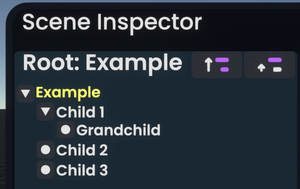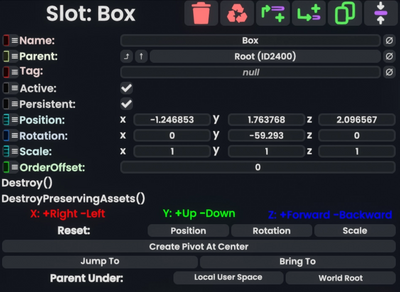Every object in Resonite exists as a Slot. Slots form hierarchies, are positioned in 3D space via their transformation, and may contain Components to add additional behavior.
Basic Properties
Hierarchy

A slot can contain zero or more slots, forming a hierarchy or "tree". A slot is a child if it is contained within another slot; that slot is its parent. The only slot without a parent is the root of the world, which contains all other slots.
This hierarchy is used for organization, transformation (see below), and many other features in Resonite.
Transformation
Each slot has a 3D transformation consisting of translation, rotation, and scale. A child slot's transformation is specified in local space, i.e. relative to its parent slot's transformation, so even though a child may use the default transforms, it may be transformed in world space due to its parents' transforms.
Components
Main article: Component
Slots contain components, which provide almost all the functionality in Resonite. See the main article for details.
Fields

Similar to Components, slots have a number of fields that can be modified:
| Name | Type | Description |
|---|---|---|
Name
|
String | The name of the component, as shown in the scene inspector. |
Parent
|
Slot | A reference to the parent slot in the hierarchy. |
Tag
|
String | A string tag used for identifying slots in various systems. |
Active
|
Bool | A general-purpose field to "disable" this slot and its components. If a slot is deactivated, its children are deactivated too. Note that not all components and features respect this field. |
Persistent
|
Bool | Whether this slot will be saved, for example to the Inventory. If this is disabled, the slot and all its descendants will not be saved. |
Position
|
Float3 | This slot's position in local space. |
Rotation
|
FloatQ | This slot's rotation in local space. |
Scale
|
Float3 | This slot's scale in local space. Defaults to (1, 1, 1). |
OrderOffset
|
Long | Controls the sort order of this slot relative to its siblings. Slots with a higher value are processed after siblings with a lower value. This controls the order both in the scene inspector and in many of Resonite's internal processes. |
Working With Slots
With the Scene Inspector
As a user, slots are primarily manipulated through the Scene Inspector. You can view, create, destroy and modify slots and their components.
With ProtoFlux
ProtoFlux has a set of nodes for working with the slot hierarchy, see Category:ProtoFlux:Slots for a list.
Limitations
- There is no way to access a Slot's components with ProtoFlux.[1]
Other Features
Slot Transferring
- Slots can be moved across worlds via a feature called Transcient Grabbing. This is when a user is holding onto a slot when focusing to a different world.